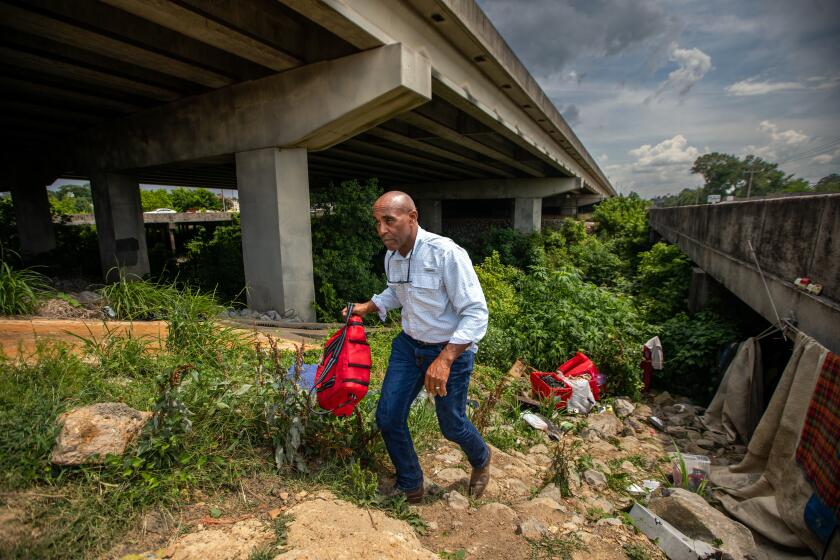Even the least expensive areas of California are becoming less affordable, and more desirable

- Share via
It’s long been a fact of life that California’s coastal cities are among the most expensive places to live in the country.
But new data show that even inland areas far from the shores — such as Modesto, Bakersfield and Stockton — are significantly less affordable compared with the national average, further worsening the housing crunch in a state facing an unprecedented crisis.
These inland areas have become magnets for coastal Californians looking for more room and cheaper property. Experts say this has helped fuel rising prices, putting housing out of reach for those with limited means in most parts of the Golden State.
“If there’s a boom in Silicon Valley, then communities even 80 or 100 miles out will have ... this ripple effect,” said USC economics Professor Matthew Kahn. “The alternative to having a small house in Silicon Valley is a bigger house elsewhere.”
Although the influx of cash from young professionals who can work remotely can be good for the state’s inland “hidden gems,” Kahn said that “if you’re a renter in those communities, your rents will soar.”
The Council for Community and Economic Research estimates that, of 274 urban areas in the U.S., four of the top 10 most expensive areas to live in are in California: San José, San Francisco, Los Angeles-Long Beach and Orange County.
Many Californians in the counties with the most affordable housing will be most at risk for extreme heat in the decades to come, according to a Times analysis.
The council’s index, which takes “housing, utilities, grocery items, transportation, healthcare, and miscellaneous goods and services” into account, estimates that the cost of living in those four California areas ranged from 47% to 75% above the national average in the second quarter of 2023.
All values are compared with the national cost-of-living index for major urban areas compiled by the council. The average figure was scaled to 100.
The top 10 California urban areas by cost of living are listed below:
- San José, 174.9% of national average
- San Francisco, 169.6%
- Los Angeles-Long Beach, 148.8%
- Orange County, 147%
- San Diego, 140%
- Oakland, 136.4%
- Sacramento, 117.9%
- Stockton, 117.6%
- Modesto, 113%
- Bakersfield, 111.5%
Though the study was focused on the top income quintile, the state’s affordability crisis has hit others even harder, causing movement away from coastal cities to booming suburbs and exurbs inland.
The conclusion jibes with RentCafe’s estimate, which puts the cost of living in California at 42% more expensive than nationwide.
L.A. County could have 1.7 million fewer people by 2060. It’s not only because residents are leaving
The state population is expected to be flat over the coming decades for the first time in California history. See which counties will gain and lose people.
Housing drives California’s high cost of living — RentCafe’s data show housing costs to be 101% more expensive than the national average. Transportation, utilities and food are 27%, 22% and 17% above average, respectively.
While some coastal California cities lost population during the pandemic, housing values rose. As of June 30, the median home price in L.A. was $975,333, an increase of more than 30% from five years prior. Some areas have crossed the million-dollar mark, including San José and San Francisco. Inland areas have seen population growth and values rise, but prices are still significantly lower. For example, the median home price was $459,000 in Modesto, and $445,000 in Stockton as of August, according to Realtor.com.
Still, every California area listed in RentCafe’s report was more expensive than the U.S. average.
As remote workers consider cities beyond the priciest in the state, the paradigm has changed, according to Kahn: Previously, “the exciting jobs were in big cities, but people couldn’t afford housing there.”
“There’s something democratic about expanding the menu of cities people can live in,” he said. And even though the cheapest cities are still more expensive than the national average, “California continues to be heaven to many people.”
As L.A. deals with a housing crisis, new data show how the threat of eviction affects not only poor communities but middle- and high-income ones too.
Andrew Zutshi, 40, moved with his wife from Palms, where they were renting, to Santa Clarita in December 2020, where they bought a home.
Since then, “the amount of money we are able to spend in everyday life has gotten better” as everyday costs are lower, the accountant said.
“You could see the property values going up and the rent going up” in L.A., Zutshi said, but he and his wife felt their quality of life was stagnating. It has improved markedly since the move.
“We know what it’s like to live in L.A. and wonder: Am I going to pay rent the rest of my life? Am I going to be able to save for anything?”
Average home values in Modesto and Bakersfield have nearly doubled since 2015, according to Zillow.
The public tends to blame homelessness on poverty, drug use, crime or even warm weather. But other cities don’t have L.A. levels of street homelessness because they have more available housing.
To prevent renters who already live in cities such as Modesto and Bakersfield from being priced out, Kahn suggested, those cities could upzone single-family housing to multifamily in areas that are less vulnerable to floods and fires.
In March, finance company SoFi put a number on the cost to live in California: $53,082 per year.
Broken down by cost, the monthly per capita average numbers came out to:
- $1,360 to $2,649 for housing.
- $380 for utilities.
- $322 for food and groceries.
- $443 to $1,256 for transportation.
- $708 for healthcare.
- $990 to $1,785 per child for child care.
Van Nuys-based astrologer and witch Gogo Akopyan promises to tell you about your past, present and future. But first: coffee, stirred clockwise, with intention.
The California Legislative Analyst’s Office, a nonpartisan fiscal and policy advisor to the state Legislature, wrote that the housing affordability crisis has forced people “to make serious trade-offs in order to live in California.”
State government has tried to address the crisis for years, but residents are unsatisfied. Seventy-four percent of voters view housing affordability as a major issue, according to a February survey by the nonpartisan Public Policy Institute of California, and nearly 90% worry that younger generations won’t be able to afford a home in the state.
“The state’s housing crisis is one of the most difficult issues facing state policymakers,” the body wrote.
Times staff writer Hannah Wiley contributed to this report.
More to Read
Sign up for Essential California
The most important California stories and recommendations in your inbox every morning.
You may occasionally receive promotional content from the Los Angeles Times.















